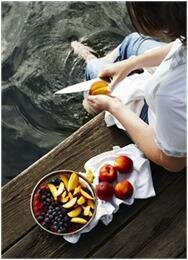Summer is here! Time to get outside and let your skin soak up that vital vitamin D. When temperatures rise, so does your chance of dehydration.

I like to try and keep things interesting and so getting to know certain foods that make all the mouth-watering difference is key! Water isn't the only thirst quencher. Foods with a high level of water content can also do the trick. Nature gives us a huge variety of fruit and vegetables that can help keep us hydrated. I love watermelons (it's in the name!), which are not only high in vitamin C but their flesh contains 92% water. I also like to include cucumbers, which are so refreshing in summer and contain the skin-smoothing caffeic acid, and are again, high in vitamin C. Other ideas that you might want to add to a salad include iceberg lettuce, which is top of the list for leafy greens that are high in water content, tomatoes (94% water), blueberries (80%), melon cantaloupes (89%) and peaches (89%). And don't forget foods such as broccoli, peppers and spinach are not only hydrating but are also UV- protecting.
Remember, think colour! Each different colour of fruit and vegetable has a key role in keeping you healthy and providing you with a variety of vitamins and minerals. For example purple foods contain powerful antioxidants which help to fight off disease, green foods are a rich source of magnesium, orange foods are rich in beta-carotene, which is needed for healthy skin and red foods are rich in lycopene, an important antioxidant needed to fight off disease.
I often find that healthy portion sizes of fruit and vegetables won't provide us with all the fluid we need but they're a great source of "time-released" fluid. Unlike a glass of water, which leaves the stomach and gets into the blood stream relatively quickly, food takes longer to be digested and therefore releases water into your system more slowly. Food contains at least half of the average person's water intake. Skin is the largest organ in the body and so needs to stay hydrated as an effective barrier! Give your skin a boost by using a great moisturiser to lock water into the skin.
How to increase your fruit and vegetable intake
1.Breakfast time
•Add chopped up fruit to your porridge. No longer shall porridge have a reputation of being like wallpaper paste. Jazzed up with blackberries, it is transformed into a lovely flavourful breakfast.
•Add bananas to your breakfast granola pot. If bananas aren't your thing then substitute with any fruit you fancy. I recommend trying cinnamon roasted apple, pear or stewed rhubarb and gooseberries.
•Add mangos to your morning bircher muesli. If you have more time, take the mango flesh, blend it and fold it through the oats mixture first!
•Blend your favourite fruits together and make a smoothie - add some natural yoghurt too! Make sure you use fruits that are in season, so your smoothie is naturally sweet. No need to add sugar!
2.Snack
•Chop and add your favourite fruits to a skewer! A perfect 'on-the-go' fruit salad, wonderful when entertaining guests or having picnics.
•Mash up avocado and use as a spread on some delicious rye-bread.
•Stock your fridge with homemade fruit ice cubes. Unbelievably refreshing for the summer months! Pop straight into your mouth or add to any drink.
3.Lunch and Dinner
•Grate carrot and courgettes into your meals. A wonderful way to bulk out salads.
•Stick your veggies in a roasting tin. Roasting vegetables is easy and brings out new flavours. Season with homemade pesto!